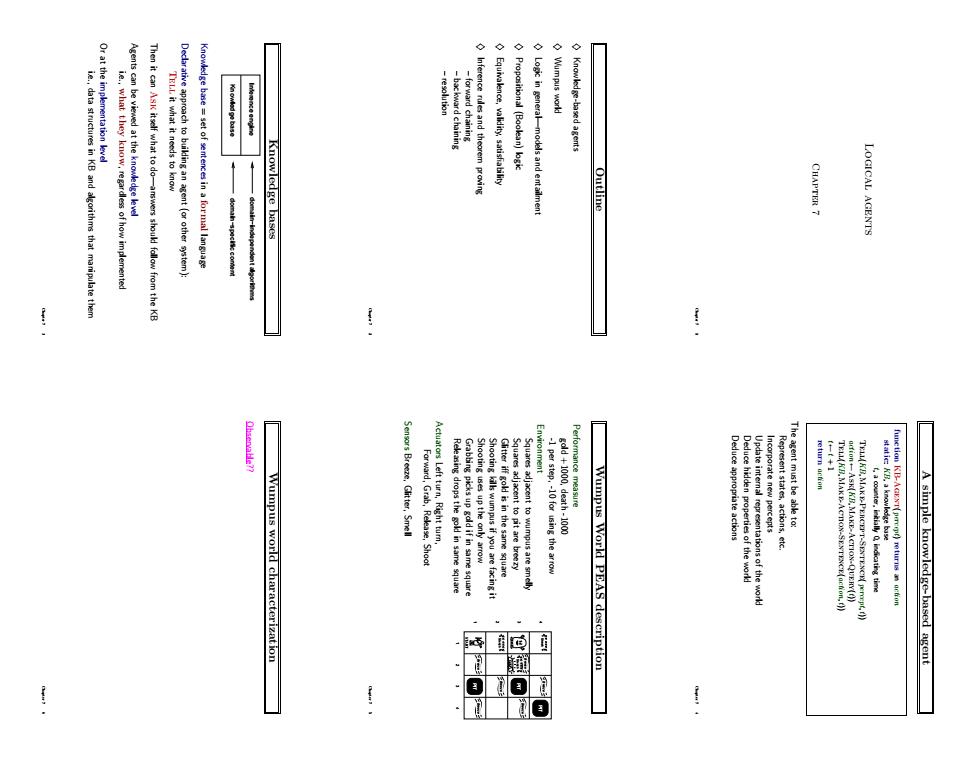
Then it cank itsef what tod-wers shoul follaw from the KB Knowledge base=set of senten ina formal language Kn owlad ge base resolution Logic in general-models and entailmen Wumpus world Knowledge bases Outline LOGICAL AGENT domain-independent .. .. Wumpus world characterization Sensrs Breeze,Glitter,Smell Wumpus World PEAS description sent states,actions,etc. The agent must be able to: Ask(KB.MAKE-ACHION-Q r-SENT A simple knowledge-based agent e
Logical agents Chapter 7 Chapter 7 1 Outline ♦ Knowledge-based agents ♦ Wumpus world ♦ Logic in general—models and entailment ♦ Propositional (Boolean) logic ♦ Equivalence, validity, satisfiability ♦ Inference rules and theorem proving – forward chaining – backward chaining – resolution Chapter 7 2 Knowledge bases Knowledge base Inference engine domain−specific content domain−independent algorithms Knowledge base = set of sentences in a formal language Declarative approach to building an agent (or other system): Tell it what it needs to know Then it can Ask itself what to do—answers should follow from the KB Agents can be viewed at the knowledge level i.e., what they know, regardless of how implemented Or at the implementation level i.e., data structures in KB and algorithms that manipulate them Chapter 7 3 A simple knowledge-based agent function KB-Agent( percept) returns an action static: KB, a knowledge base t, a counter, initially 0, indicating time Tell(KB,Make-Percept-Sentence( percept,t)) action ←Ask(KB,Make-Action-Query(t)) Tell KB ( ,Make-Action-Sentence(action,t)) t ← t + 1 return action The agent must be able to: Represent states, actions, etc. Incorporate new percepts Update internal representations of the world Deduce hidden properties of the world Deduce appropriate actions Chapter 7 4 Wumpus World PEAS description Performance measure gold +1000, death -1000 -1 per step, -10 for using the arrow Environment Squares adjacent to wumpus are smelly Squares adjacent to pit are breezy Glitter iff gold is in the same square Shooting kills wumpus if you are facing it Shooting uses up the only arrow Grabbing picks up gold if in same square Releasing drops the gold in same square Breeze Breeze Breeze Breeze Breeze Stench Stench Breeze PIT PIT PIT 1 2 3 4 1 2 3 4 START Gold Stench Actuators Left turn, Right turn, Forward, Grab, Release, Shoot Sensors Breeze, Glitter, Smell Chapter 7 5 Wumpus world characterization Observable?? Chapter 7 6
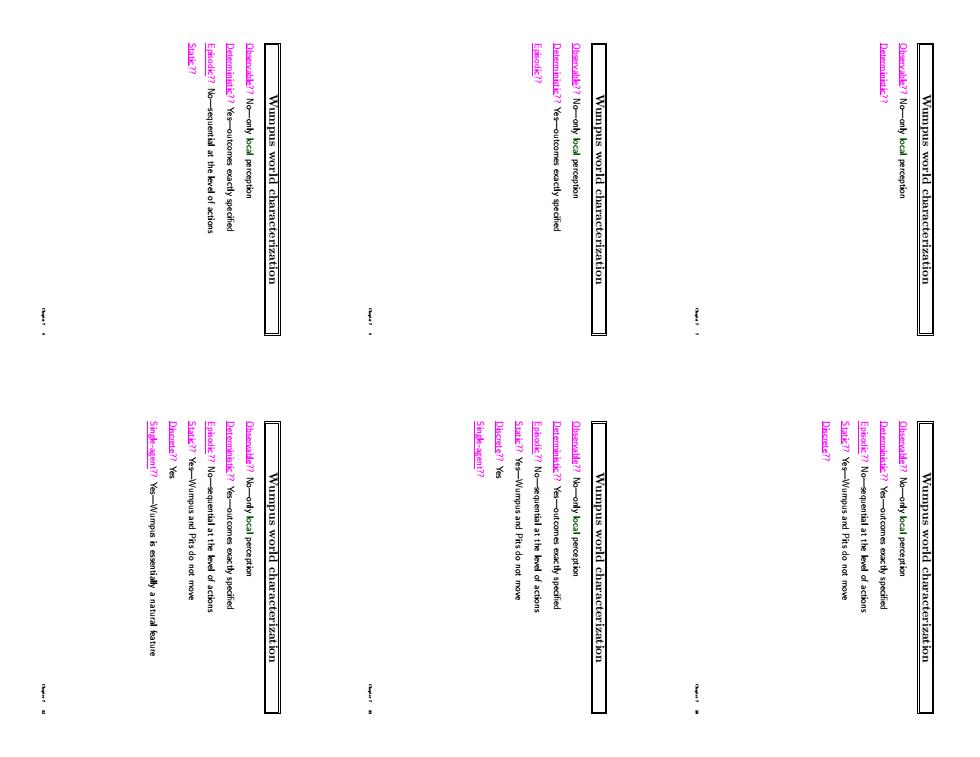
Wumpus world characterization No-only lcal perception Wumpus world characterization Wumpus world characterization Yes-Wumpus is essentially a natural featur Yes-Wumpus and Pits do nat move Yes-outcomes xctly specifie Wumpus world characterization No-ony lcal perception Wumpus world characterization StaticYes-Wumpus and Pits do not move Wumpus world characterization .!
Wumpus world characterization Observable?? No—only local perception Deterministic?? Chapter 7 7 Wumpus world characterization Observable?? No—only local perception Deterministic?? Yes—outcomes exactly specified Episodic?? Chapter 7 8 Wumpus world characterization Observable?? No—only local perception Deterministic?? Yes—outcomes exactly specified Episodic?? No—sequential at the level of actions Static?? Chapter 7 9 Wumpus world characterization Observable?? No—only local perception Deterministic?? Yes—outcomes exactly specified Episodic?? No—sequential at the level of actions Static?? Yes—Wumpus and Pits do not move Discrete?? Chapter 7 10 Wumpus world characterization Observable?? No—only local perception Deterministic?? Yes—outcomes exactly specified Episodic?? No—sequential at the level of actions Static?? Yes—Wumpus and Pits do not move Discrete?? Yes Single-agent?? Chapter 7 11 Wumpus world characterization Observable?? No—only local perception Deterministic?? Yes—outcomes exactly specified Episodic?? No—sequential at the level of actions Static?? Yes—Wumpus and Pits do not move Discrete?? Yes Single-agent?? Yes—Wumpus is essentially a natural feature Chapter 7 12
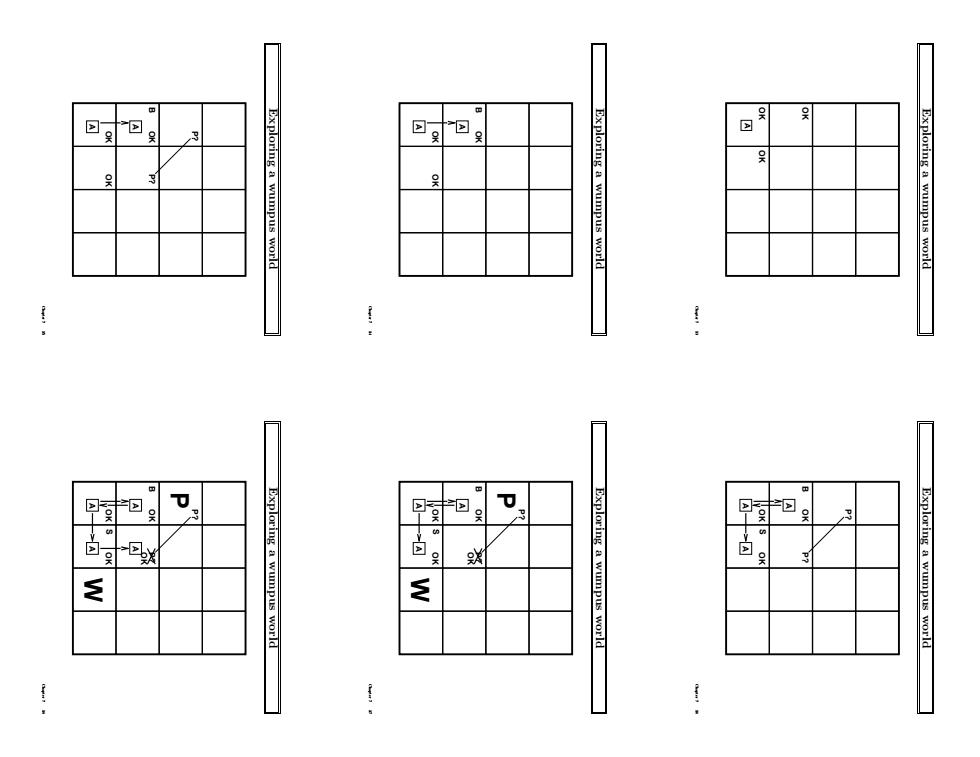
回 9 回 回 Exploring a wumpus world Exploring a wumpus world Exploring a wumpus world 回 Exploring a wumpus world Exploring a wumpus world Exploring a wumpus world
Exploring a wumpus world A OK OK OK Chapter 7 13 Exploring a wumpus world OK OK OK A A B Chapter 7 14 Exploring a wumpus world OK OK OK A A B P? P? Chapter 7 15 Exploring a wumpus world OK OK OK A A B P? P? A S Chapter 7 16 Exploring a wumpus world OK OK OK A A B P? P? A S OK P W Chapter 7 17 Exploring a wumpus world OK OK OK A A B P? P? A S OK P W A Chapter 7 18
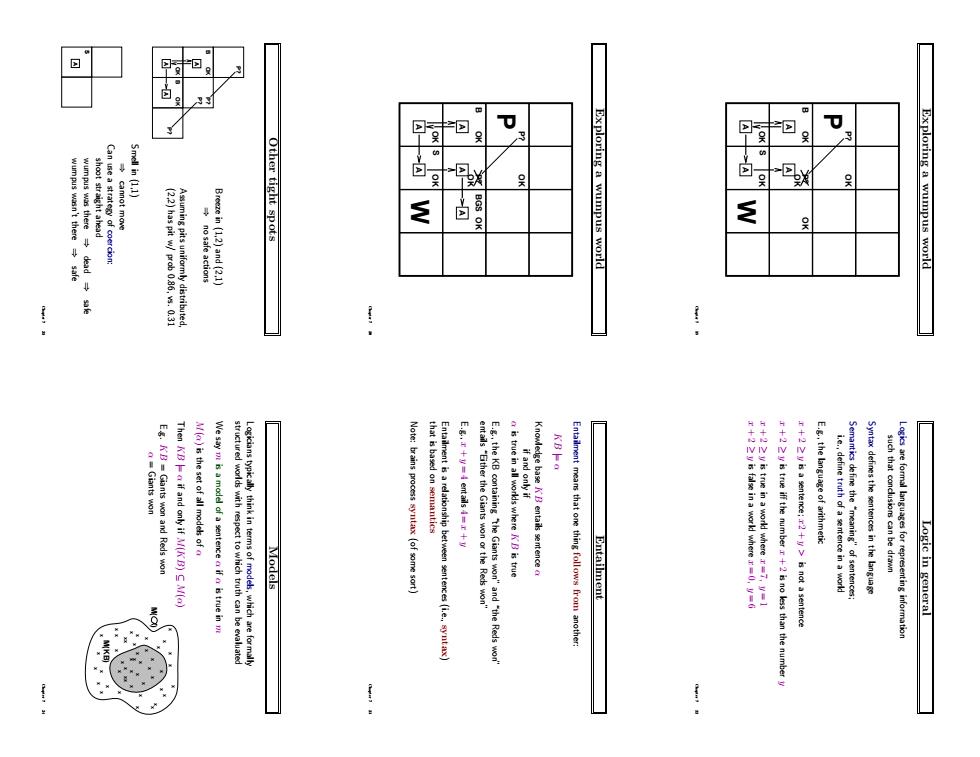
0 9 n pus shoot straight ahead Can ue a strategy of coercion: cannot move Other tight spots Exploring a wumpus world Exploring a wumpus world ThenKBa if and only if M(KB)C M(a) Note:brains pocess(ofm sort) that is based on semantics E.g.+y=4 entails4=r+y Egthe language of arithmetic Models Entailment +2i true iff the number+is no lss than the number Syntax defnesthes intheangug Logic in general
Exploring a wumpus world OK OK OK A A B P? P? A S OK P W A OK OK Chapter 7 19 Exploring a wumpus world OK OK OK A A B P? P? A S OK P W A OK OK A BGS Chapter 7 20 Other tight spots A B OK OK OK A B A P? P? P? P? Breeze in (1,2) and (2,1) ⇒ no safe actions Assuming pits uniformly distributed, (2,2) has pit w/ prob 0.86, vs. 0.31 A S Smell in (1,1) ⇒ cannot move Can use a strategy of coercion: shoot straight ahead wumpus was there ⇒ dead ⇒ safe wumpus wasn’t there ⇒ safe Chapter 7 21 Logic in general Logics are formal languages for representing information such that conclusions can be drawn Syntax defines the sentences in the language Semantics define the “meaning” of sentences; i.e., define truth of a sentence in a world E.g., the language of arithmetic x + 2 ≥ y is a sentence; x2 + y > is not a sentence x + 2 ≥ y is true iff the number x + 2 is no less than the number y x + 2 ≥ y is true in a world where x = 7, y = 1 x + 2 ≥ y is false in a world where x = 0, y = 6 Chapter 7 22 Entailment Entailment means that one thing follows from another: KB |= α Knowledge base KB entails sentence α if and only if α is true in all worlds where KB is true E.g., the KB containing “the Giants won” and “the Reds won” entails “Either the Giants won or the Reds won” E.g., x + y = 4 entails 4 = x + y Entailment is a relationship between sentences (i.e., syntax) that is based on semantics Note: brains process syntax (of some sort) Chapter 7 23 Models Logicians typically think in terms of models, which are formally structured worlds with respect to which truth can be evaluated We say m is a model of a sentence α if α is true in m M(α) is the set of all models of α Then KB |= α if and only if M(KB) ⊆ M(α) E.g. KB = Giants won and Reds won α = Giants won M( ) M(KB) x x x x x x x x x x x x x x x x x x x x x x x x x xx x x x x x x x x x x x x x x x x x x x x Chapter 7 24
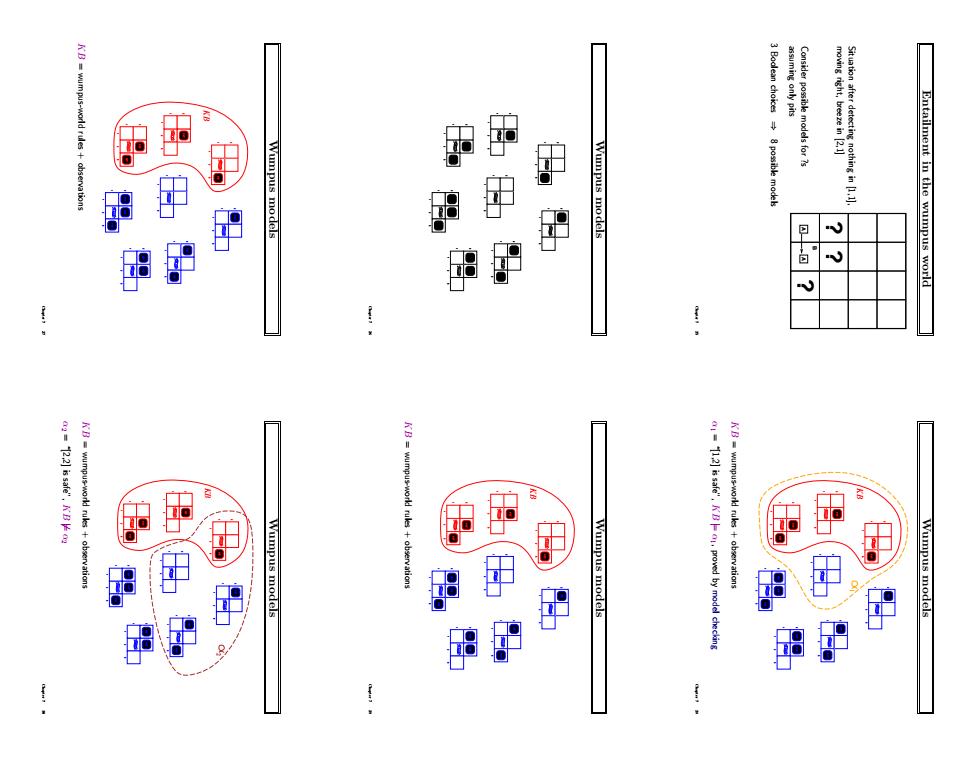
碎 Wumpus models 3 Bodlean choices 8 possible modeb Entailment in the wumpus world 西 ... o2=122]is safe".B o A=wumpus world ruks obse B=wumpus-world rules +observ Wumpus models Wumpus models +058
Entailment in the wumpus world Situation after detecting nothing in [1,1], moving right, breeze in [2,1] Consider possible models for ?s assuming only pits A A B ? ? ? 3 Boolean choices ⇒ 8 possible models Chapter 7 25 Wumpus models 1 2 3 1 2 Breeze PIT 1 2 3 1 2 Breeze PIT 1 2 3 1 2 Breeze PIT PIT PIT 1 2 3 1 2 Breeze PIT PIT 1 2 3 1 2 Breeze PIT 1 2 3 1 2 Breeze PIT PIT 1 2 3 1 2 Breeze PIT PIT 1 2 3 1 2 Breeze Chapter 7 26 Wumpus models 1 2 3 1 2 Breeze PIT 1 2 3 1 2 Breeze PIT 1 2 3 1 2 Breeze PIT PIT PIT 1 2 3 1 2 Breeze PIT PIT 1 2 3 1 2 Breeze PIT 1 2 3 1 2 Breeze PIT PIT 1 2 3 1 2 Breeze PIT PIT 1 2 3 1 2 Breeze KB KB = wumpus-world rules + observations Chapter 7 27 Wumpus models 1 2 3 1 2 Breeze PIT 1 2 3 1 2 Breeze PIT 1 2 3 1 2 Breeze PIT PIT PIT 1 2 3 1 2 Breeze PIT PIT 1 2 3 1 2 Breeze PIT 1 2 3 1 2 Breeze PIT PIT 1 2 3 1 2 Breeze PIT PIT 1 2 3 1 2 Breeze KB 1 KB = wumpus-world rules + observations α1 = “[1,2] is safe”, KB |= α1, proved by model checking Chapter 7 28 Wumpus models 1 2 3 1 2 Breeze PIT 1 2 3 1 2 Breeze PIT 1 2 3 1 2 Breeze PIT PIT PIT 1 2 3 1 2 Breeze PIT PIT 1 2 3 1 2 Breeze PIT 1 2 3 1 2 Breeze PIT PIT 1 2 3 1 2 Breeze PIT PIT 1 2 3 1 2 Breeze KB KB = wumpus-world rules + observations Chapter 7 29 Wumpus models 1 2 3 1 2 Breeze PIT 1 2 3 1 2 Breeze PIT 1 2 3 1 2 Breeze PIT PIT PIT 1 2 3 1 2 Breeze PIT PIT 1 2 3 1 2 Breeze PIT 1 2 3 1 2 Breeze PIT PIT 1 2 3 1 2 Breeze PIT PIT 1 2 3 1 2 Breeze KB 2 KB = wumpus-world rules + observations α2 = “[2,2] is safe”, KB 6|= α2 Chapter 7 30

is true and Propositional logic:Semantics If 5 andS are sentences.sntence (implication) sentences,(disjunction) If s is a sentence,is a sntence (negation) The propoition etc are sentences Propositional logic:Syntax sentence o can be derived fromB by procedure Inference .. Wumpus world sentences Wumpus world sentences Truth tables for connectives
Inference KB `i α = sentence α can be derived from KB by procedure i Consequences of KB are a haystack; α is a needle. Entailment = needle in haystack; inference = finding it Soundness: i is sound if whenever KB `i α, it is also true that KB |= α Completeness: i is complete if whenever KB |= α, it is also true that KB `i α Preview: we will define a logic (first-order logic) which is expressive enough to say almost anything of interest, and for which there exists a sound and complete inference procedure. That is, the procedure will answer any question whose answer follows from what is known by the KB. Chapter 7 31 Propositional logic: Syntax Propositional logic is the simplest logic—illustrates basic ideas The proposition symbols P1, P2 etc are sentences If S is a sentence, ¬S is a sentence (negation) If S1 and S2 are sentences, S1 ∧ S2 is a sentence (conjunction) If S1 and S2 are sentences, S1 ∨ S2 is a sentence (disjunction) If S1 and S2 are sentences, S1 ⇒ S2 is a sentence (implication) If S1 and S2 are sentences, S1 ⇔ S2 is a sentence (biconditional) Chapter 7 32 Propositional logic: Semantics Each model specifies true/false for each proposition symbol E.g. P1,2 P2,2 P3,1 true true false (With these symbols, 8 possible models, can be enumerated automatically.) Rules for evaluating truth with respect to a model m: ¬S is true iff S is false S1 ∧ S2 is true iff S1 is true and S2 is true S1 ∨ S2 is true iff S1 is true or S2 is true S1 ⇒ S2 is true iff S1 is false or S2 is true i.e., is false iff S1 is true and S2 is false S1 ⇔ S2 is true iff S1 ⇒ S2 is true and S2 ⇒ S1 is true Simple recursive process evaluates an arbitrary sentence, e.g., ¬P1,2 ∧ (P2,2 ∨ P3,1) = true ∧ (false ∨ true) = true ∧ true = true Chapter 7 33 Truth tables for connectives P Q ¬P P ∧ Q P ∨ Q P⇒Q P⇔Q false false true false false true true false true true false true true false true false false false true false false true true false true true true Chapter true 7 34 Wumpus world sentences Let Pi,j be true if there is a pit in [i, j]. Let Bi,j be true if there is a breeze in [i, j]. ¬P1,1 ¬B1,1 B2,1 “Pits cause breezes in adjacent squares” Chapter 7 35 Wumpus world sentences Let Pi,j be true if there is a pit in [i, j]. Let Bi,j be true if there is a breeze in [i, j]. ¬P1,1 ¬B1,1 B2,1 “Pits cause breezes in adjacent squares” B1,1 ⇔ (P1,2 ∨ P2,1) B2,1 ⇔ (P1,1 ∨ P2,2 ∨ P3,1) “A square is breezy if and only if there is an adjacent pit” Chapter 7 36
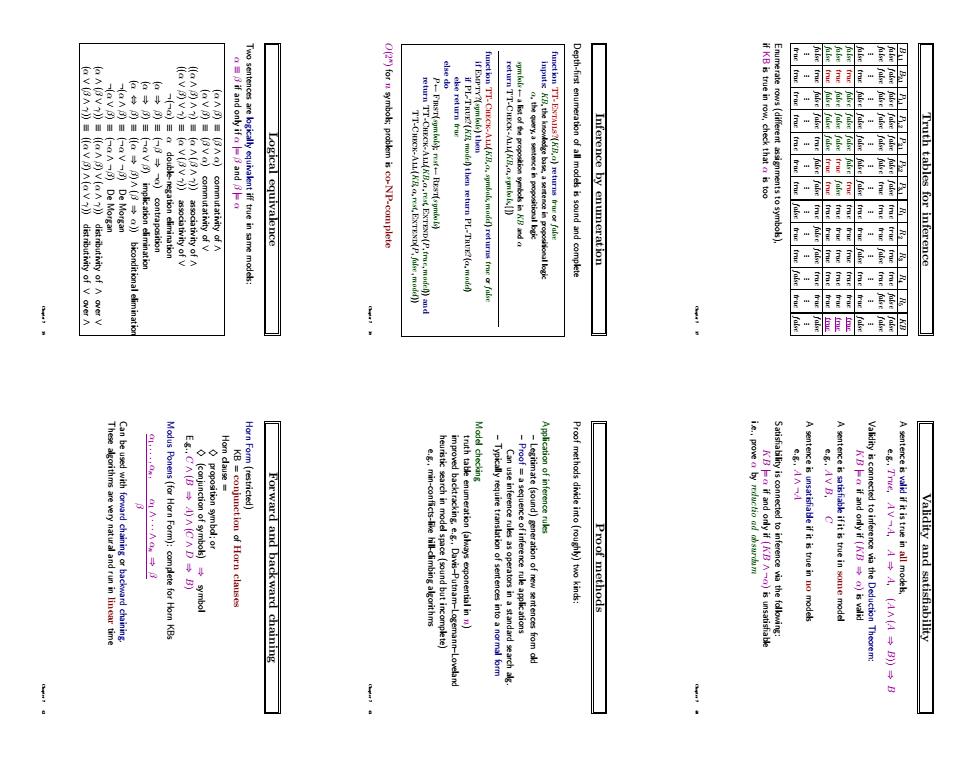
[ A)De Morgan 8 c double-negation eliminatio Logical equivalence O[2)for n symbok;probkem is co-NP-complete TT-CnEcK-A.modd)returns tme fals Depth-first enumeration ofall models is sound and complete Inference by enumeration Truth tables for inference Modus Ponens(for Horn Form):complete for Hor KBs Forward and backward chaining enumeration (al -Typically require translation of sentences into a normal orm rC Ca Proof methods ntenceissiable ifit is true inme mode A sentence is valid if it is true in all modeb, Validity and satisfiability
Truth tables for inference B1,1 B2,1 P1,1 P1,2 P2,1 P2,2 P3,1 R1 R2 R3 R4 R5 KB false false false false false false false true true true true false false false false false false false false true true true false true false false . . . . . . . . . . . . . . . . . . . . . . . . . . . . . . . . . . . . . . . false true false false false false false true true false true true false false true false false false false true true true true true true true false true false false false true false true true true true true true false true false false false true true true true true true true true false true false false true false false true false false true true false . . . . . . . . . . . . . . . . . . . . . . . . . . . . . . . . . . . . . . . true true true true true true true false true true false true false Enumerate rows (different assignments to symbols), if KB is true in row, check that α is too Chapter 7 37 Inference by enumeration Depth-first enumeration of all models is sound and complete function TT-Entails?(KB,α) returns true or false inputs: KB, the knowledge base, a sentence in propositional logic α, the query, a sentence in propositional logic symbols ← a list of the proposition symbols in KB and α return TT-Check-All(KB,α,symbols, [ ]) function TT-Check-All(KB,α,symbols, model) returns true or false if Empty?(symbols) then if PL-True?(KB, model) then return PL-True?(α, model) else return true else P do ← First(symbols); rest ← Rest(symbols) return TT-Check-All(KB,α, rest,Extend(P,true, model)) and TT-Check-All(KB,α, rest,Extend(P,false, model)) O(2 n ) for n symbols; problem is co-NP-complete Chapter 7 38 Logical equivalence Two sentences are logically equivalent iff true in same models: α ≡ β if and only if α |= β and β |= α (α ∧ β) ≡ (β ∧ α) commutativity of ∧ (α ∨ β) ≡ (β ∨ α) commutativity of ∨ ((α ∧ β) ∧ γ) ≡ (α ∧ (β ∧ γ)) associativity of ∧ ((α ∨ β) ∨ γ) ≡ (α ∨ (β ∨ γ)) associativity of ∨ ¬(¬α) ≡ α double-negation elimination (α ⇒ β) ≡ (¬β ⇒ ¬α) contraposition (α ⇒ β) ≡ (¬α ∨ β) implication elimination (α ⇔ β) ≡ ((α ⇒ β) ∧ (β ⇒ α)) biconditional elimination ¬(α ∧ β) ≡ (¬α ∨ ¬β) De Morgan ¬(α ∨ β) ≡ (¬α ∧ ¬β) De Morgan (α ∧ (β ∨ γ)) ≡ ((α ∧ β) ∨ (α ∧ γ)) distributivity of ∧ over ∨ (α ∨ (β ∧ γ)) ≡ ((α ∨ β) ∧ (α ∨ γ)) distributivity of ∨ over ∧ Chapter 7 39 Validity and satisfiability A sentence is valid if it is true in all models, e.g., True, A ∨ ¬A, A ⇒ A, (A ∧ (A ⇒ B)) ⇒ B Validity is connected to inference via the Deduction Theorem: KB |= α if and only if (KB ⇒ α) is valid A sentence is satisfiable if it is true in some model e.g., A ∨ B, C A sentence is unsatisfiable if it is true in no models e.g., A ∧ ¬A Satisfiability is connected to inference via the following: KB |= α if and only if (KB ∧ ¬α) is unsatisfiable i.e., prove α by reductio ad absurdum Chapter 7 40 Proof methods Proof methods divide into (roughly) two kinds: Application of inference rules – Legitimate (sound) generation of new sentences from old – Proof = a sequence of inference rule applications Can use inference rules as operators in a standard search alg. – Typically require translation of sentences into a normal form Model checking truth table enumeration (always exponential in n) improved backtracking, e.g., Davis–Putnam–Logemann–Loveland heuristic search in model space (sound but incomplete) e.g., min-conflicts-like hill-climbing algorithms Chapter 7 41 Forward and backward chaining Horn Form (restricted) KB = conjunction of Horn clauses Horn clause = ♦ proposition symbol; or ♦ (conjunction of symbols) ⇒ symbol E.g., C ∧ (B ⇒ A) ∧ (C ∧ D ⇒ B) Modus Ponens (for Horn Form): complete for Horn KBs α1, . . . , αn, α1 ∧ · · · ∧ αn ⇒ β β Can be used with forward chaining or backward chaining. These algorithms are very natural and run in linear time Chapter 7 42
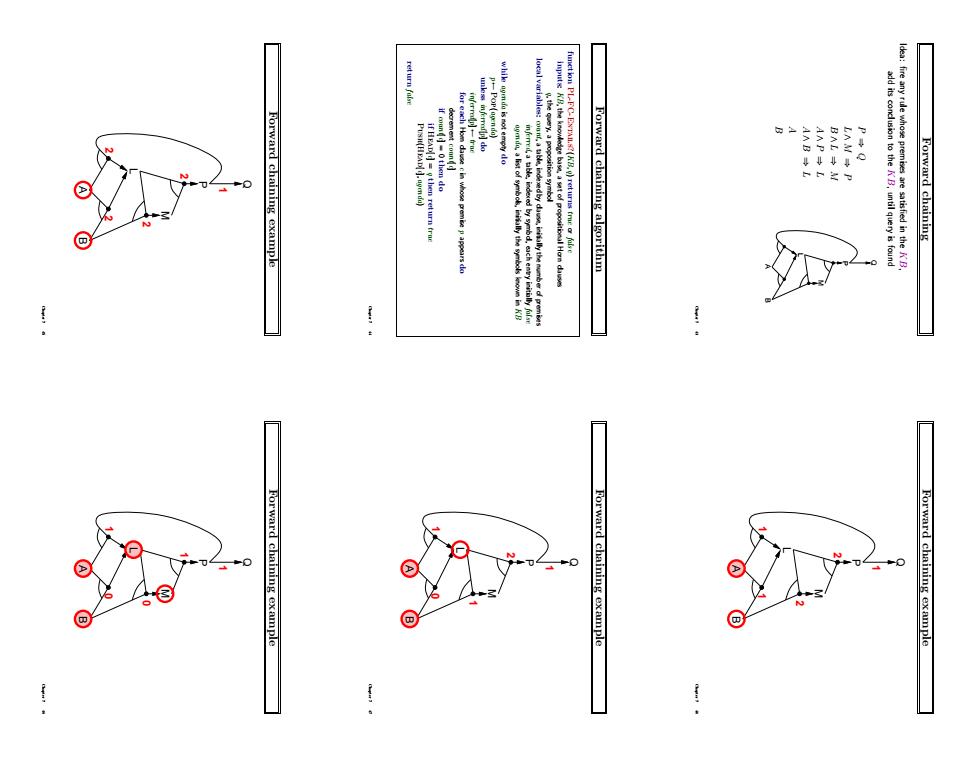
Forward chaining example Forward chaining algorithm add its condusion to the AB,until query is found ldea:fire any rule whose prembes are satisfied in theB Forward chaining 1 Forward chaining example Forward chaining example Forward chaining example
Forward chaining Idea: fire any rule whose premises are satisfied in the KB, add its conclusion to the KB, until query is found P ⇒ Q L ∧ M ⇒ P B ∧ L ⇒ M A ∧ P ⇒ L A ∧ B ⇒ L B A P Q M L B A Chapter 7 43 Forward chaining algorithm function PL-FC-Entails?(KB, q) returns true or false inputs: KB, the knowledge base, a set of propositional Horn clauses q, the query, a proposition symbol local variables: count, a table, indexed by clause, initially the number of premises inferred, a table, indexed by symbol, each entry initially false agenda, a list of symbols, initially the symbols known in KB while agenda is not empty do p ← Pop(agenda) unless inferred[p] do inferred[p] ←true for each Horn clause c in whose premise p appears do decrement count[c] if count[c] = 0 then do if Head[c] = q then return true Push(Head[c], agenda) return false Chapter 7 44 Forward chaining example P Q M L B A 2 2 2 2 1 Chapter 7 45 Forward chaining example P Q M L B 2 A 1 1 1 2 Chapter 7 46 Forward chaining example P Q M 2 A 1 1 B 0 1 L Chapter 7 47 Forward chaining example P Q M A 1 1 B 0 L 0 1 Chapter 7 48
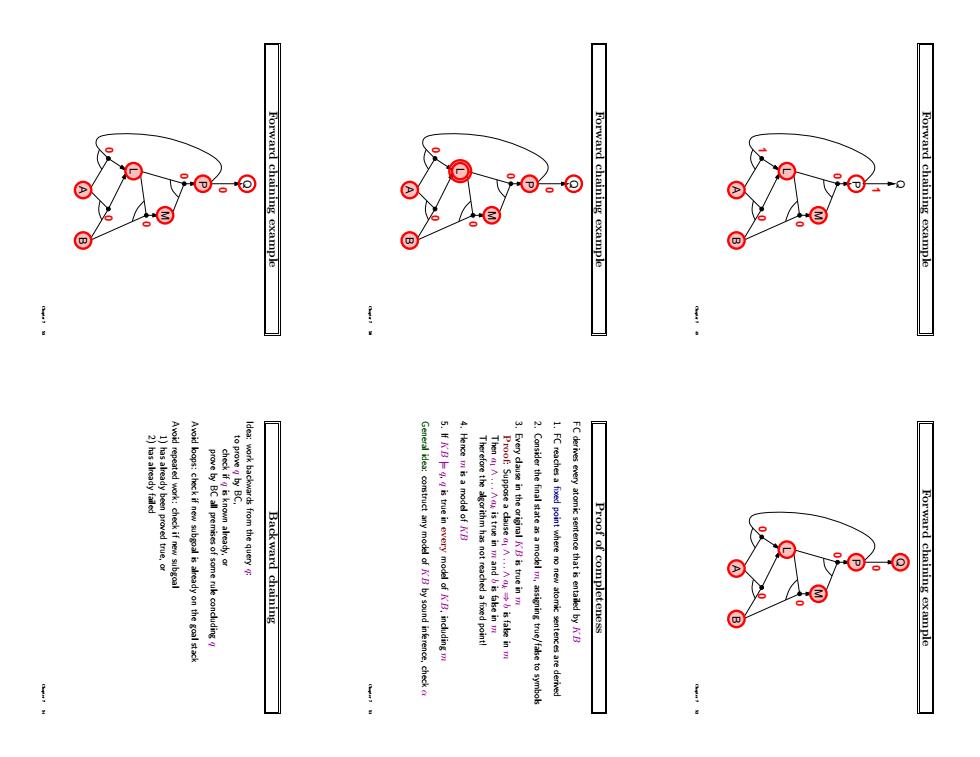
⊙ Forward chaining example Forward chaining example Forward ⊙ ③ ing example proved true,o repeated work:check if new subgoal Avoid lops:check if new subgoal is already on the goal stack Backward chaining General idea:comstruct any model of B by sound inference.check 5.true in every model of KB,incudingm Hence m is a madel of ithm has not derives every atomic sentence that is entailed by Proof of completeness Forward chai 。⊙ ning example
Forward chaining example Q A 1 1 B 0 L 0 M 0 P Chapter 7 49 Forward chaining example Q A B 0 L 0 M 0 P 0 0 Chapter 7 50 Forward chaining example Q A B 0 L 0 M 0 P 0 0 Chapter 7 51 Forward chaining example A B 0 L 0 M 0 P 0 0 Q Chapter 7 52 Proof of completeness FC derives every atomic sentence that is entailed by KB 1. FC reaches a fixed point where no new atomic sentences are derived 2. Consider the final state as a model m, assigning true/false to symbols 3. Every clause in the original KB is true in m Proof: Suppose a clause a1 ∧ . . . ∧ ak ⇒ b is false in m Then a1 ∧ . . . ∧ ak is true in m and b is false in m Therefore the algorithm has not reached a fixed point! 4. Hence m is a model of KB 5. If KB |= q, q is true in every model of KB, including m General idea: construct any model of KB by sound inference, check α Chapter 7 53 Backward chaining Idea: work backwards from the query q: to prove q by BC, check if q is known already, or prove by BC all premises of some rule concluding q Avoid loops: check if new subgoal is already on the goal stack Avoid repeated work: check if new subgoal 1) has already been proved true, or 2) has already failed Chapter 7 54

Backward chaining example Backward chaining example Backward chaining example Backward chaining example Backward chaining example
Backward chaining example P Q M L A B Chapter 7 55 Backward chaining example P M L A Q B Chapter 7 56 Backward chaining example M L A P Q B Chapter 7 57 Backward chaining example M A P Q L B Chapter 7 58 Backward chaining example M L A P Q B Chapter 7 59 Backward chaining example M A P Q L B Chapter 7 60